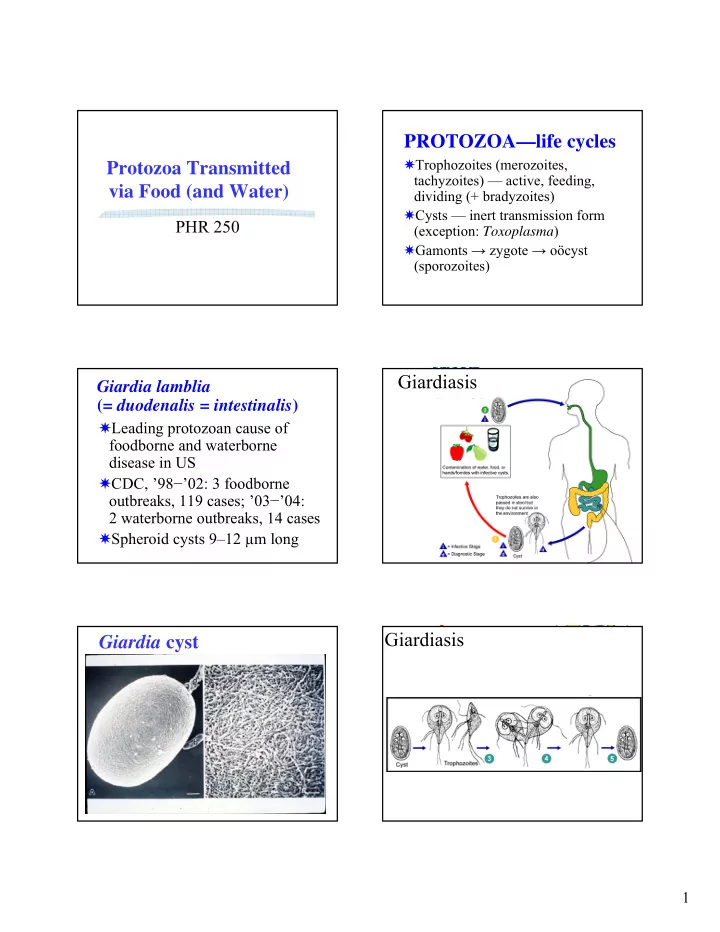

PROTOZOA—life cycles � Trophozoites (merozoites, Protozoa Transmitted tachyzoites) — active, feeding, via Food (and Water) dividing (+ bradyzoites) � Cysts — inert transmission form PHR 250 (exception: Toxoplasma ) � Gamonts → zygote → oöcyst (sporozoites) Giardiasis Giardia lamblia ( = duodenalis = intestinalis ) � Leading protozoan cause of foodborne and waterborne disease in US � CDC, ’98 − ’02: 3 foodborne outbreaks, 119 cases; ’03 − ’04: 2 waterborne outbreaks, 14 cases � Spheroid cysts 9–12 µm long Giardiasis Giardia cyst 1
Giardia trophozoite Giardia lamblia � Incubation 7–10 days; characteristic diarrhea from noninvasive colonization of upper small intestine may persist for weeks if untreated; asymptomatic infections very common. � Reservoirs: humans, beavers, cattle, and other animals. Giardia lamblia vehicles Cryptosporidium parvum � Unfiltered surface water ( Giardia is fairly resistant to � Oöcysts from humans, cattle, chlorine) other domestic & wild species � Drinking water recontaminated (human-specific species: “ C. with sewage hominis” ) � Fruits, vegetables, salads, and � Small (4–6 µm), tough, chlorine- other foods subject to direct or resistant indirect fecal contamination Cryptosporidium parvum Cryptosporidium parvum � Outbreaks from apple juice � Largest outbreak of waterborne (cider) 1993 & 1996, and raw disease in history (Milwaukee, milk and a few other food 1993, ca. 403,000 cases, but only vehicles one waterborne U.S. outbreak � CDC (’98–’02): 4 outreaks, 130 during ’03–’04 cases � FoodNet (2005): ~8850 cases 2
Cryptosporidium C. parvum, C. hominis hominis � Incubation ~1 week, profuse diarrhea usually <30 days (shedding 2–6 months); intracellular parasitism; treatment is rehydration. C. parvum oocyst C. parvum excysting Cryptosporidium parvum or C. parvum sporozoites C. hominis 3
C. parvum or C. hominis C. parvum or C. hominis � Concern for cryptosporidiosis � Cryptosporidiosis is (especially waterborne) is diagnostic of AIDS in evoking stringent measures in HIV-positive persons & the U.S. and will have a will generally persist significant impact on (with intermittent agriculture involving symptoms) for life. ruminants. Entamœba histolytica Entamœba histolytica � Causes amebic dysentery, � Once a frequent cause of sometimes abscesses of liver waterborne disease in the or other organs (trophozoites US, now fairly rare here are invasive). � Continues to be a very � Human-specific; transmitted significant threat in the via fecally contaminated poorer countries. water or food. Entamœba histolytica Entamœba histolytica 4
Entamœba histolytica Entamœba histolytica Toxoplasma gondii Toxoplasma gondii � Outbreaks (acute, foodborne) rare � CAST: ~2090 cases, 42 deaths, $2.6 billion/yr (×½?) from congenital blindness, hydrocephalus, retardation T. gondii life cycle Toxoplasma gondii � Cats are definitive hosts, usually Cat: definitive infected by eating infected birds host or rodents; oöcysts (not External immediately infective) in cat environment feces for up to 3 weeks Intermediate hosts contaminate animal feed, garden vegetables, other foods, water . 5
T. gondii oocyst Toxoplasma gondii T. gondii tissue cyst Toxoplasma gondii � Tissue cysts (bag of bradyzoites ) in pork, mutton, beef — killed by cooking or irradiation; freezing does not eliminate them completely. Toxoplasma gondii Cyclospora cayetanensis � Tachyzoites may encyst in � Human-specific; delayed various tissues (often CNS in maturation (days to weeks humans); cellular immune under favorable conditions) of response causes encystation as oöcysts in feces makes person- bradyzoites; tissue cysts well to-person transmission unlikely. tolerated in humans but may be � Fairly common in parts of Latin reactivated if immunity is later America and Asia impaired. 6
Cyclospora cayetanensis Cyclospora cayetanensis � Rare in U.S., but caused an � CDC (‘98–’02): 9 outbreaks, extensive (nationwide + Canada) 325 cases outbreak in May–June of 1996, � FoodNet (2005): ~450 cases eventually attributed to raspberries imported from Guatemala; again in 1997; embargoed in U.S. (but not Canada) in 1998; back in 1999? Cyclospora cayetanensis Cyclospora cayetanensis Summary Cyclospora cayetanensis � Limited look at foodborne � Presently, there are just four protozoa Guatemalan farms that may be � Five agents discussed; three permitted to export raspberries species ( Cryptosporidium to the U.S., contingent on fecal hominis, Cyclospora cayetanensis testing of the farm workers. & Entamœba histolytica ) are � No positive fecal tests had human-specific & transmitted by resulted, at last report. a fecal-oral route. 7
Summary � Others all transmitted zoonotically at least some of the time, either via infected animal feces or tissue � Human feces also important sources of Cryptosporidium hominis (& parvum ?) oöcysts and Giardia lamblia cysts that may be transmitted to humans via water or food. 8
Recommend
More recommend